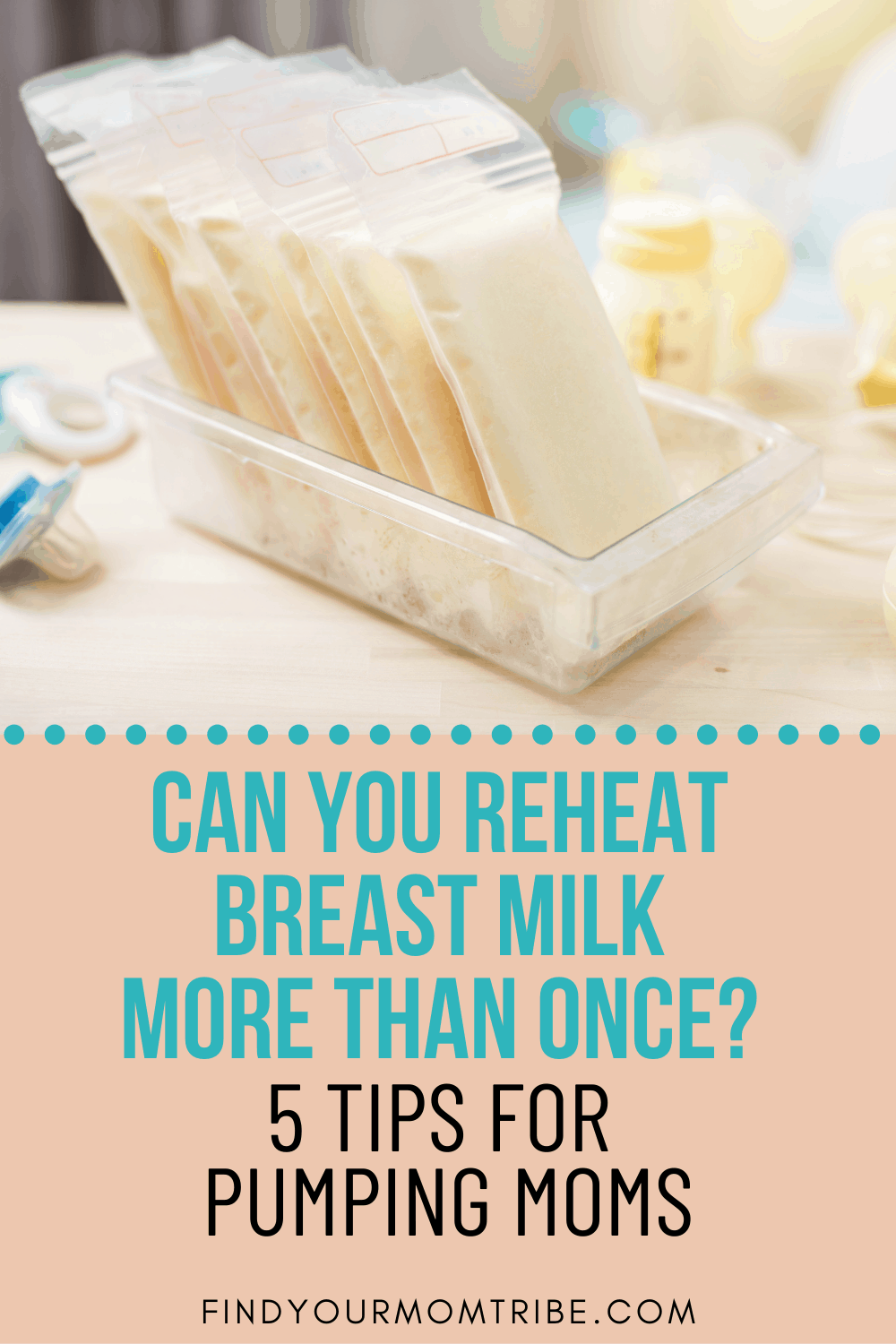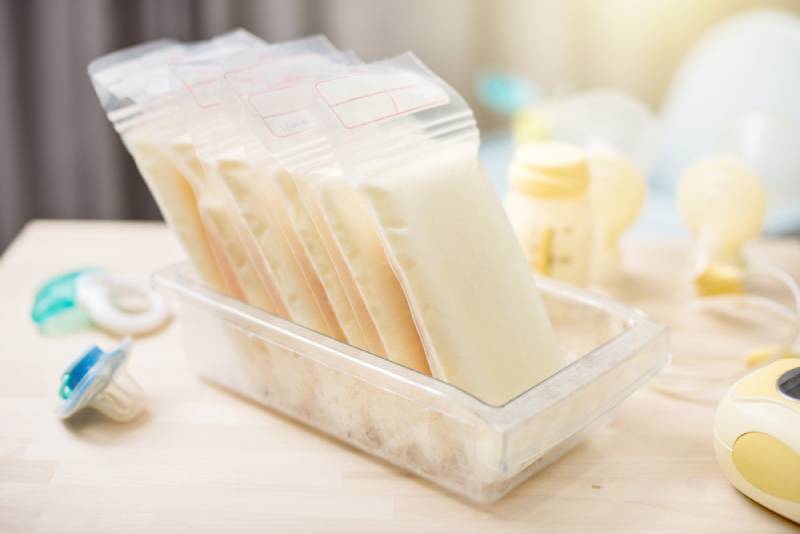There are so many things we as nursing moms need to think about. We always prefer playing it safe overall, whether it comes to baby food, baby wipes, or toys.
But one question I often get asked, especially by new moms, is can you reheat breast milk more than once?
Expressed breast milk, if used incorrectly, can be potentially dangerous for your child and that’s why it’s important to follow storage guidelines and reheat it safely.
Pumping and storing breast milk in the refrigerator or freezer is a smart choice for a mama when her baby cannot be breastfed directly or if she has a milk oversupply.
The only downside to this method is having to heat up the stored milk before feeding it to your baby.
But what if your little one doesn’t manage to finish his bottle of breast milk in one feeding session? Can you pop the leftover milk back in the fridge/freezer to reuse for a later feed?
How many times can you reheat your milk before it becomes a risk to your baby’s health?
Let’s unpack these questions.
Can You Reheat Breast Milk More Than Once?
In short: No, it is not safe to heat up a bottle of breast milk more than once.
That is, after you have thawed and warmed up frozen milk once (or warmed up stored expressed breast milk from the refrigerator), any milk that is left over should be discarded if not used within 2 hours after a feed, and not stored again for later feeding.
While I know this might feel like a waste to pour your precious liquid gold down the drain, there are good reasons behind discarding any leftover reheated milk.
Although it’s true that bacteria grows at a slower pace in human milk than in baby formulas, reheating breast milk more than once is still a risk better left untaken.
Once the milk makes contact with your little one’s saliva, there is a chance it can become contaminated with bacteria (and we all know these nasties love dairy!)
Also, every time heat is applied to (any) milk, some nutritional value is lost. This is why it’s also important to follow safe thawing and reheating methods (which I’ll cover in a moment) to not destroy those all-important nutrients that your growing baby needs.
Since the jury’s out scientifically on how many times you can reheat breast milk for it to still be considered safe and nutritional for babies, it’s best to stick to the CDC’s Human Milk Storage Guidelines, which, as highlighted before, is to “use [leftover milk from a feeding] within 2 hours after the baby is finished feeding.”
The Academy of Breastfeeding Medicine supports this stance in its Clinical Protocol #8: Human Milk Storage Information for Home Use for Full-Term Infants:
“Once a baby begins drinking expressed human milk, some bacterial contamination occurs in the milk from the baby’s mouth.
The duration of time the milk can be kept at room temperature once the baby has partially fed from the cup or bottle would theoretically depend on the initial bacterial load in the milk, how long the milk has been thawed, and the ambient temperature.
There have been no studies done to provide recommendations in this regard. Based on related evidence thus far, it seems reasonable to discard the remaining milk within 1–2 hours after the baby is finished feeding.”
How To SAFELY Store And Reheat Breast Milk
1. Store pumped milk ASAP
The role of a parent requires 24/7 devotion and not leaving anything to chance. Trust me, I know it sometimes feels that you’re running around like a headless chicken with everything you need to do and remember.
And in all that rush and overthinking, you can too easily forget to do one simple thing.
One of them is putting off storing your breast milk as soon as possible after pumping. You probably already know the drill. You say to yourself, “I’ll refrigerate/freeze breast milk after I change his diaper or put him down for his nap.”
Refrigerating or freezing milk right after expressing will help preserve its nutrients and prevent it from going off. That said, your circumstances may make it a challenge to store it immediately after a pumping session.
If you’re pumping at work or on the go, it’s reassuring to know that your breast milk is good for up to 4 hours at room temperature. A better idea, however, is to keep your freshly expressed milk in an insulated cooler bag with ice packs. This cooling technique will do the job for up to 24 hours.
2. Check the quality of the milk before rewarming it
Another breast milk storage rule is to check the quality of the milk before reheating it. After all, relying on your five senses is probably one of the safest methods of checking the quality of certain products, especially milk.
What you need to do is look for any clues that indicate spoiled milk, the most common of which are a strong smell, a lumpy consistency, and perhaps even a change in color.
If you notice that there is a fat layer on the surface, try shaking the milk. If the fat layer doesn’t mix with the rest of the milk after shaking, then you shouldn’t reheat the milk.
SEE ALSO: Top 10 Breast Milk Storage Containers
3. When reheating, slow and easy does it
One of the main reasons for mothers wanting to breastfeed their children is to make sure that their little ones are getting all the fabulous nutrients and antibodies found in breast milk that are needed for optimal development.
As touched on earlier, incorrect reheating of stored milk can result in the loss of valuable nutrients and good bacteria. But, not all hope is lost! The following tips will by and large prevent this.
Avoid microwaving
A hectic lifestyle often forces us to look for instant solutions in every aspect of our life, and baby feeding is no exception.
Sometimes, when you’re dealing with a cranky, hungry, little munchkin who does not yet understand the concept of waiting, you may decide to warm up your stored milk in the microwave to spare a little time.
Well, bad idea. And the reason you should avoid microwaving is that studies have shown both baby formula and baby’s milk are heated unevenly in a microwave.
This results in what is called hot spots that are potentially dangerous because they might scald your baby’s mouth and throat. Also, that heat may destroy some of the nutrients and immune-boosting components.
Safe methods to defrost and reheat stored breast milk
There are a few ways in which you can reheat your stored milk safely. Here are the most common ones.
• A bowl of warm water
You can warm breast milk by placing the bottle or storage bag in a bowl of warm water or lukewarm water (not boiling hot water) for approximately two minutes.
You can use this method for thawing frozen milk as well.
• Running water
Another practical way of warming up milk is by holding the stored milk under warm or hot running water. Do keep in mind, though, that this method will require more of your time than the previous one.
• Bottle warmer
Now here’s one magical device that is perfectly safe and easy to use. Joking aside, it is not really a magical device but pretty darn close, if you ask me – it made those nights that hubby took the feeds that much easier!
All you need to do is pop your stored milk inside the bottle warmer and it will be warmed up within minutes. Some bottle warmers even come with a feature where they automatically shut off.
Needless to say how practical and ingenious this is (especially for those of us suffering from a bit of mommy brain!)
The best of all is that most models come with multiple functions for both warming and defrosting. Also, they come in different sizes, which is great if you happen to have a bigger bottle than the regular ones.
Some even have a food-warming feature, making it a worthy buy for when your little one transitions to solid foods.
It is important to note that certain bottle warmers are not suited for warming up bottles made of glass, so always check the product specifications and warnings.
4. Test the temperature of reheated breast milk
After having warmed up breast milk, you need to check whether the temperature is suitable for your baby. Most infants prefer their milk at around body temperature (the same as directly from the breast) or room temperature; some don’t even mind drinking cold milk.
The best way to test that it’s not too hot is by putting some of the milk on the inside of your wrist. If the temperature is right, you shouldn’t feel any heat whatsoever – it’ll feel lukewarm, not hot or cold.
If it is too hot, then you can either wait for it to cool down or hold it under some cold running water for a bit before serving it to your little one.
5. DO NOT give your child reheated breast milk if:
• your baby is sick, or
• your baby is born prematurely.
The main reason in these two instances is it won’t really be beneficial, since, through the reheating process, human milk loses much of its immunological properties.
It goes without saying that premature and ill babies need the best possible immunity boost they can get. Therefore, sensitive babies should be fed with fresh breast milk whenever possible.
EXTRA TIPS
• You can keep thawed breast milk at room temperature for 1 to 2 hours, or in the refrigerator for a maximum of 24 hours (counting from when it is defrosted, not when you first placed it frozen in the fridge to start defrosting).
• When pumping and storing, be sure to use breast milk storage bags or bottles that are BPA-free.
• To avoid harmful bacteria, remember to wash storage containers and bottles thoroughly in hot soapy water. Also, be sure to follow the cleaning instructions that come with your breast pump.
• If you’re packing in bottles or storage bags for daycare, put your child’s name on them so that you know your little one is getting your liquid gold (you laugh now, but trust me, accidental switcharoos happen more often than you think!)
Wrapping It Up
I hope I succeeded in giving you a helpful answer to the question: Can you reheat breast milk more than once? If you have any more queries or concerns about handling breast milk, breastfeeding, and similar, have a look at CDC Storage Guidelines.
And if by any chance you pick up on any changes in your little one’s feeding routine, make sure to contact your doctor or lactation consultant.
That’s a wrap for now. All that’s left is to wish you happy feedings and a healthy baby!
References:
- CDC’s Human Milk Storage Guidelines, “Proper Storage and Preparation of Breast Milk” last reviewed January 22, 2020.
- The Academy of Breastfeeding Medicine, “Clinical Protocol #8: Human Milk Storage Information for Home Use for Full-Term Infants”, revised 2017.
READ NEXT: Is High Lipase Milk A Problem And How To Deal With It?

This post contains affiliate links. Please see our full disclosure for more info.

